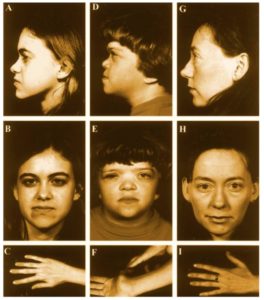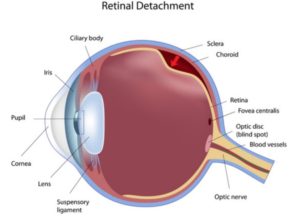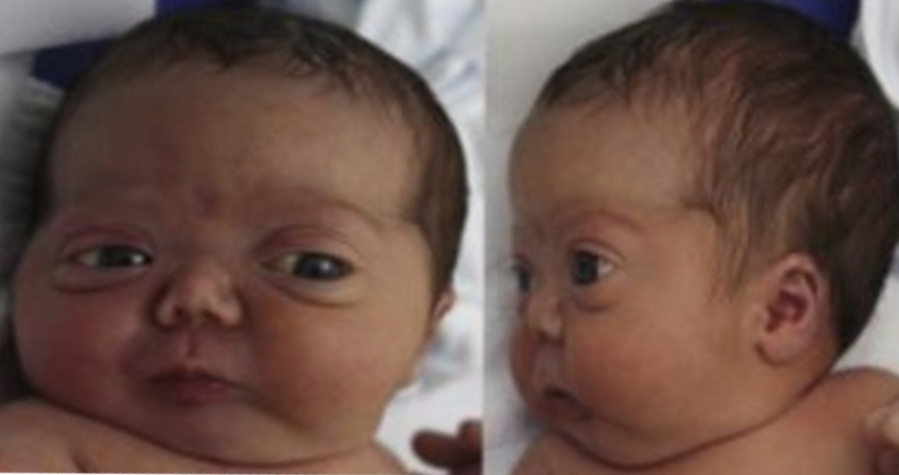Definition
Stickler syndrome is a group of autosomal dominant hereditary conditions characterized by a distinctive, rather flattened, facial appearance, eye abnormalities, hearing loss, and joint problems. (Syphilis) Stickler syndrome is a disorder of the connective tissue, the tissue that supports or surrounds organs and other types of tissue.
Etymology
Hereditary progressive arthro-ophthalmodystrophy.
Etiology
Stickler Syndrome is a genetic condition inherited in an autosomal dominant manner (Syphilis), inheriting a single copy of the altered gene from one of the parents and passed on to 50% of the children. Individuals may have any or all of the following- hearing loss, vision loss due to high myopia, arthritis-like joint disease, and cleft palate (Syphilis). Most also have a characteristic face with flat cheekbones. All are caused by genes affecting collagen, the fibers like structures, present in the cartilage of the joints, vitreous humor and supporting structures of the ears and other organs (Psora/ Syphilis). Stickler syndrome is a subtype of collagenopathy, types II and XI.
Three genes responsible for Stickler syndrome have been identified- COL2A1, COL11A1, and COL11A2. All of these genes code for type II procollagen, precursor to the so-called fibrillar collagens which are a major component of cartilage and vitreous humor.
Types
On the basis of clinical findings either two or three types exist. Types 1 and 3 have normal or mild hearing loss while type 2 starts with mild loss and progresses to profound loss (Psora/ Syphilis). Vision loss, on the other hand, is similar for types 1 and 2 but type 3 has no vision loss and is the so-called “non-ocular” form. All can get arthritis-like symptoms and some in each type may have cleft palate (Syphilis).
| Symptom | Type 1 | Type 2 | Type 3 |
| Hearing | Normal or mild loss | Moderate to profound loss, usually progressive | High tone loss, slowing progressing to involve low tones as well |
| Balance | Usually normal | ? may be affected | Usually normal |
| Vision | High myopia with vitreous changes +/- high pressure and retinal tears | High myopia with vitreous changes +/- high pressure and retinal tears | Normal |
| Joints | Young people – extremely flexible Later arthritis-like symptoms Progressive spine problems lead to back pain |
Like type 1 | About 1/2 have like type 1 |
| Mouth | Some with cleft palate or submucous cleft palate | Some with cleft palate or submucous cleft palate | A few have cleft palate |
| Gene location | COL2A1
12q13 |
COL11A1
1p21 |
COL11A2
6p21. |
Signs and symptoms
Facial features
Patients with Stickler syndrome have characteristic face with flat cheekbones. Face looks to be scooped out in middle. They may also have cleft palate (Syphilis).

High myopia
The eyeball is elongated front to back so that lenses are needed to refocus the image on the back of the eye when viewing objects at a distance. (Psora/ Syphilis)

As the eyeball is so long, the back layers of the eye may stretch and tear apart causing further vision loss. The pressure in the eyeball can also increase causing glaucoma. (Psora/ Sycosis/ Syphilis)
Hearing Loss
In all types, babies might be born with normal hearing or mild high tone loss. However, those with type 1 may remain normal while those with type 3 generally have a progressive loss. In type 2 the loss is usually moderate to profound and is often progressive. (Psora/ Syphilis)
Arthritis
In young people, there are extremely flexible joints and later develop arthritis-like symptoms with progressive spine problems leading to back pain. (Psora/ Sycosis/ Syphilis)
Gait
In most cases balance is normal. In II type, balance due to vestibular involvement may be slightly abnormal.
Stickler syndrome may be associated with an increased incidence of mitral valve prolapse of the heart. (Psora/ Syphilis)
Differential diagnosis
Marshall syndrome is similar to Stickler syndrome except that affected individuals have flattening not only of the cheekbones but also the nose and the bones around the eyes. The eyes appear quite prominent as a result. People with this condition may also have changes in COL11A1.
Several short stature conditions are caused by COL2A1-
• Achondrogenesis type 2- a severe inherited disorder of bone growth characterized by a short body and limbs and a lack of bone formation in the spine and pelvis.
• Hypochondrogenesis– a rare, severe disorder of bone growth. This condition is characterized by a small body, short limbs, and abnormal bone formation (ossification) in the spine and pelvis.
• Kniest dysplasia– a disorder of bone growth characterized by short stature (dwarfism) with other skeletal abnormalities and problems with vision and hearing.
• Spondyloepimetaphyseal dysplasia, Strudwick type- characterized by disproportionate short stature from birth (with a very short trunk and shortened limbs) and skeletal abnormalities (lordosis, scoliosis, flattened vertebrae, pectus carinatum, coxa vara, clubfoot, and abnormal epiphyses or metaphyses.
Two short-stature conditions are also caused by COL11A2 changes. These are-
• Otospondylomegaepiphyseal dysplasia (OSMED) – a condition characterized by skeletal abnormalities, distinctive facial features, and severe hearing loss.
• Weissenbacher-Zweymüller syndrome– is characterized by skeletal abnormalities, hearing loss, and distinctive facial features. The features of this condition significantly overlap those of two similar conditions, otospondylomegaepiphyseal dysplasia (OSMED) and Stickler syndrome type III.
Diagnosis
While Stickler syndrome can occasionally be diagnosed based on medical history and a physical exam, additional tests are needed to determine the severity of the symptoms and prognosis. These tests include- X-rays for abnormalities or damage in the joints and spine and molecular genetic testing. The diagnosis of Stickler syndrome is confirmed in individuals with a heterozygous pathogenic variant in COL2A1, COL11A1, or COL11A2 or biallelic pathogenic variants in COL9A1, COL9A2, or COL9A3.
Diagnostic criteria for Stickler syndrome
(Rose P.S. et al., Am J Med Genet. 138A:199-207, 2005)
Orofacial abnormalities (2 points maximum)-
– Cleft palate (open cleft, submucous cleft, or bifid uvula): major, 2 points
– Characteristic facial features (malar hypoplasia, broad or flat nasal bridge, and micro/retrognathia): 1 point
Ocular abnormalities (2 points maximum)-
– Characteristic vitreous changes or retinal abnormalities (lattice degeneration, retinal hole, retinal detachment or retinal tear): major, 2 points
Auditory abnormalities (2 points maximum)-
– High-frequency sensorineural hearing loss: major, 2 points
o Age < 20 years: threshold ≥ 20 dB at 4-8 kHz
o Age 20-40 years: threshold ≥ 30 dB at 4-8 kHz
o Age > 40 years: threshold ≥ 40 dB at 4-8 kHz
– Hypermobile tympanic membranes: 1 point
Skeletal abnormalities (2 points maximum)-
– Femoral head failure (slipped epiphysis or Legg-Perthes-like disease): 1 point
– Radiographically demonstrated osteoarthritis before age 40: 1 point
– Scoliosis, spondylolisthesis, or Scheuermann-like kyphotic deformity: 1 point
Family history/molecular data*- (*does not account for families with autosomal recessive Stickler syndrome)
– Independently affected first-degree relative in a pattern consistent with autosomal dominant inheritance or presence of a COL2A1, COL11A1, or COL11A2 mutation associated with Stickler syndrome: 1 point
Diagnosis of Stickler syndrome
A diagnostic scale of 9 points is evaluated by molecular data or family history data and characteristic ocular, orofacial, auditory, and musculoskeletal findings. A score of > or =5 is diagnostic of Stickler syndrome.
Treatment
Treatment for Stickler syndrome is symptomatic only. In some cases, this may involve surgeries to correct cleft palate or retinal detachment. Other treatments may include hearing aids for hearing loss or medications for joint pain.
Homoeopathic treatment
Since homoeopathy deals with holistic theory to cure the sick individuals, not the diseases, it is of much help in treatment of Stickler syndrome. After correct evaluation of case and correct remedy administration, miracles are seen. There are certain homoeopathic remedies which exclusively work on collagen tissue. These are of much value in treating such a disorder.
Homoeopathic remedies for collagen disorders
acet-ac. am-caust. anan. arg-met. ars-i. ars. calen. carb-v. carc. cortiso. crot-h. cyclop. cyclosp. des-ac. germ-met. graph. kali-ar. lach. med. merc. mur-ac. nit-ac. penic. phos. plut-n. psor. rhus-t. saroth. stann. suis-chord-umb. sulph. syph. thuj. tub-r. tub. uncar-tom. urin.
Common remedies for Stickler Syndrome
abel. Acon. aeth. Agar. alco. Am-c. Am-p. Anac. ang. ant-c. Ant-t. anthraco. apis arec. arg-met. Arg-n. ARN. Ars. atro. Aur-m. Aur. bar-ox-suc. BELL. ben-d. benz-ac. berb. bov. Bry. bufo cadm-s. Calc-caust. calc-p. Calc. Camph. canth. caps. carb-ac. Carb-v. carbn-s. caul. caust. cedr. Cham. chel. chim. chin. Cic. cimic. cinnb. Clem. cocain. cocc. coff-t. colch. coloc. com. Con. conin. cortico. cortiso. croc. crot-h. Cupr. Cycl. dig. Dulc. esin. euon. euph. Euphr. ferr. fl-ac. form. Gels. Glon. Graph. grat. grin. guaj. guare. hell. hep. Hydr-ac. Hyos. ictod. iod. Jab. kali-bi. kali-c. Kali-i. kali-s. lac-c. Lach. Laur. led. lil-t. Lith-c. Lyc. m-ambo. mag-c. manc. Mang. med. Meph. merc-c. merc. mez. Mosch. naphtin. nat-ar. Nat-c. Nat-m. nat-p. nat-pyru. Nit-ac. nux-v. ol-an. Ol-j. olnd. onos. op. Osm. par. Petr. Ph-ac. PHOS. PHYS. phyt. Pic-ac. pilo. pipe. Plat. plb. pot-a. prun. Psor. PULS. ran-s. raph. retin-ac. rhod. Rhus-t. Ruta santin. saroth. sec. sel. Sil. Spig. spong. Stann. Stel. still. STRAM. streptoc. stroph-s. Sul-ac. sul-ter. Sulph. suprar. Syph. tarent. tax. tell. Ter. Thuj. Tub. Valer. verat-v. verat. verb. viol-o. viol-t. wies. wildb.
Short repertory of Stickler Syndrome
CHEST – HEART; complaints of the – Valves – Mitral valve kali-c. psor. stroph-s.
CHEST – MURMURS – cardiac murmurs – valvular – Mitral valve carb-ac. dig. kali-c. onos.
EXTREMITIES – LOOSENESS – sensation of looseness – Joints agar. arg-met. arg-n. bov. bry. bufo calc-p. caps. caust. chel. croc. dulc. fl-ac. kali-bi. m-ambo. med. nat-c. nat-m. ph-ac. phos. phyt. Psor. STRAM. sulph. thuj. wildb.
EXTREMITIES – PAIN – Joints – chronic Am-p. ant-c. anthraco. benz-ac. berb. Bry. Calc-caust. calc. carbn-s. caul. Caust. cimic. colch. Dulc. euon. ferr. guaj. hep. iod. kali-bi. kali-c. Kali-i. led. Lith-c. lyc. med. merc. mez. Ol-j. petr. phyt. Puls. rhod. Rhus-t. ruta sil. Stel. still. streptoc. sul-ter. Sulph. tax.
EYE – CATARACT – children; in mag-c.
EYE – CATARACT – progressive chim.
EYE – DETACHMENT of retina abel. acon. apis ARN. Aur-m. aur. ben-d. dig. Gels. naphtin. nux-v. phos. pilo. ruta
EYE – DISTORTED Acon. Agar. alco. ang. Arn. Ars. BELL. bry. cadm-s. calc-p. Camph. canth. carb-ac. carb-v. Cham. Chel. Chin. Cic. cocc. colch. con. conin. crot-h. Cupr. dig. hell. Hydr-ac. Hyos. kali-s. Lach. Laur. merc-c. Merc. Mosch. olnd. op. petr. ph-ac. Plat. plb. puls. ran-s. santin. sec. Sil. spig. Stann. Stram. sul-ac. Sulph. tarent. Thuj. verat-v. verat.
EYE – GLAUCOMA – accompanied by – Eye; pain in acon. mez. Phos. rhod.
EYE – GLAUCOMA – accompanied by – vision; iridescent osm.
EYE – GLAUCOMA – chronic saroth.
EYE – GLAUCOMA acon. arec. ars. atro. aur. Bell. berb. bry. calc. camph. caust. cedr. cinnb. Clem. cocain. cocc. colch. coloc. com. cortico. cortiso. croc. crot-h. esin. gels. Glon. grin. ictod. kali-c. kali-i. lac-c. lach. lyc. mag-c. merc. mez. nat-pyru. nux-v. op. Osm. par. Phos. Phys. pipe. plb. pot-a. prun. Puls. rhod. Rhus-t. sil. Spig. streptoc. sulph. suprar. syph. tell. Ter. thuj. wies.
FACE – DISTORTION – congenital Syph.
FACE – HIPPOCRATIC – children; in aeth. ars. Carb-v. chin.
HEARING – IMPAIRED – alternating with – Eye symptoms guare. manc.
HEARING – IMPAIRED – children; in calc. med.
NOSE – SUNKEN nose – children, infants; in Aur-m.
NOSE – SUNKEN nose ant-t. Aur. hep. merc. Psor. sil.
VISION – MYOPIA – children; in bar-ox-suc.
VISION – MYOPIA acon. Agar. Am-c. Anac. ang. Ant-t. apis arec. Arg-n. ars. aur-m. bell. Calc. Carb-v. carbn-s. Chin. cimic. coff-t. Con. Cycl. dig. euph. Euphr. form. Gels. Graph. grat. hep. Hyos. Jab. Lach. lil-t. Lyc. Mang. Meph. mez. nat-ar. Nat-c. Nat-m. nat-p. Nit-ac. ol-an. Petr. Ph-ac. PHOS. PHYS. Pic-ac. pilo. Plat. plb. psor. PULS. raph. retin-ac. Ruta sel. spong. Stram. Sul-ac. Sulph. syph. Thuj. Tub. Valer. verb. viol-o. viol-t.
Bibliography
Chapter 20. Cleft Lip & Palate > Stickler Syndrome CURRENT Diagnosis & Treatment in Otolaryngology—Head & Neck Surgery, 3e… Stickler syndrome is an association between clefts and ocular abnormalities, including fairly severe myopia presenting at an early age, as well as retinal abnormalities. Generally, an examination by a pediatric ophthalmologist is recommended for children with clefts to make or rule out…
Chapter 54. Hereditary Hearing Impairment > Stickler Syndrome CURRENT Diagnosis & Treatment in Otolaryngology—Head & Neck Surgery, 3e … Three phenotypes corresponding to three defective genes have been described in Stickler syndrome. The clinical signs include eye symptoms (eg, myopia, astigmatisms, and cataracts), arthropathy, cleft palate, and sensorineural hearing loss. Hearing loss can be mild to profound, progressive…
CONNECTIVE TISSUE AND BONE > CONNECTIVE TISSUE The Big Picture: Medical Biochemistry… humor (eye). Types II and XI collagenopathies [achondrogenesis type 2, hypochondrogenesis, Kniest dysplasia, otospondylomegaepiphyseal dysplasia, spondyloepimetaphyseal dysplasia (Strudwick type), spondyloepiphyseal dysplasia congenita, spondyloperipheral dysplasia, Stickler syndrome, Weissenbacher…
Encyclopedia Homoeopathica
Eye > Treatment Current Diagnosis & Treatment: Pediatrics, 24e… Treatment of retinal detachment is surgical. Examination under anesthesia with prophylactic cryotherapy or laser photocoagulation is recommended for all patients with Stickler syndrome. …
Hereditary Disorders of Connective Tissue > Key Words Clinical Genomics: Practical Applications in Adult Patient Care… phenotype, mitral valve prolapse, patent ductus arteriosus, Stickler syndrome, Weill-Marchesani syndrome …
Heritable Disorders of Connective Tissue > Classification Harrison’s Principles of Internal Medicine, 20e… the eye. Mild forms are more difficult to classify. Among the features are cataracts, degeneration of the vitreous, and retinal detachment, high forehead, hypoplastic facies, cleft palate, short extremities and gross distortions of the epiphyses, metaphyses, and joint surfaces. Patients with Stickler…
Heritable Disorders of Connective Tissue > Classification Harrison’s Principles of Internal Medicine… the eye. Mild forms are more difficult to classify. Among the features are cataracts, degeneration of the vitreous, retinal detachment, high forehead hypoplastic facies, cleft palate, short extremities, and gross distortions of the epiphyses, metaphyses, and joint surfaces. Patients with Stickler’s…
Heritable Disorders of Connective Tissue > Incidence Harrison’s Principles of Internal Medicine, 20e… The overall incidence of all forms of CD ranges from 1 per 2500 to 1 per 4000 births. Data on the frequency of individual CDs are incomplete, but the incidence of the Stickler syndrome is 1 in 10,000. Therefore, the disease is probably among the more common heritable disorders of connective…
Information Flow and Levels of Regulation > Part 2: Medical Genetics Medical Genetics: An Integrated Approach… Stickler syndrome Hereditary arthro-ophtalmopathy Premature osteoarthritis Onset in third decade GLI-Kruppel Family Member 3 GLI3 Pallister-Hall syndrome Hamartoma in the hypothalamus, postaxial polydactyly, imperforate anus, malformations of many other systems Greig…
Radar 10
The Extracellular Matrix > CHONDRODYSPLASIAS ARE CAUSED BY MUTATIONS IN GENES ENCODING TYPE II COLLAGEN & FIBROBLAST GROWTH FACTOR RECEPTORS Harper’s Illustrated Biochemistry, 31e… is the Stickler syndrome, manifested by degeneration of the joint cartilage and of the vitreous body of the eye. The best known of the chondrodysplasias is achondroplasia, the most common cause of short-limbed dwarfism. Affected individuals have short limbs, normal trunk size, macrocephaly, and a variety…
About Author
Dr. Rajneesh Kumar Sharma M.D. (Homoeopathy) Homoeo Cure & Research Institute, India


